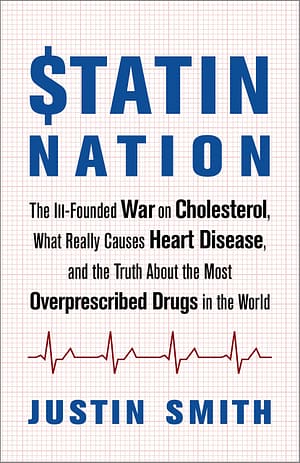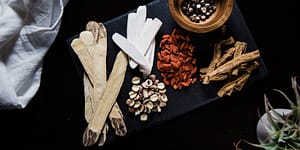The Ill-Founded War on Cholesterol: The “Good” and “Bad” Cholesterol Fallacy

A fear of cholesterol has been ingrained in many people, starting as soon as they are old enough to read the side of a Cheerios box. As the popular understanding of cholesterol has been shaped, we have made a clear distinction between “good” and “bad” cholesterol. However, this could all be fallacy, cholesterol provides valuable functions to our cells in both its “good” and “bad” forms. Statistics of cholesterol levels in heart patients that simply do not support hypotheses of cholesterol being such a menace to our cardiovascular health.
The following excerpt is from Justin Smith’s book Statin Nation: The Ill-Founded War on Cholesterol, What Really Causes Heart Disease, and the Truth About the Most Overprescribed Drug in the World and has been adapted for the web.
Most people are familiar with the concept of “good” and “bad” cholesterol. High density lipoproteins (HDLs) are considered “good” and low density lipoproteins (LDLs), such as those warned against by the British Heart Foundation, are “bad.” These designations are quite remarkable considering the fact that HDLs and LDLs are not really cholesterol.
Cholesterol does not mix with water; therefore, in order for it to be transported through the bloodstream it has to be carried inside something called a lipoprotein. A lipoprotein is an assemblage of fats, protein, and other substances that move around the body. Lipoproteins carry a number of very important materials that are needed by the body’s cells, and they also participate in the immune system. HDLs and LDLs do contain cholesterol, but they also contain CoQ10, vitamin E, beta-carotene, and other substances. The cholesterol found in HDLs is exactly the same as the cholesterol found in LDLs. The explanation we are given for HDLs being “good” and LDLs being “bad” is related to their direction of travel within the body.
Most cholesterol is made in the liver. LDLs transport cholesterol from the liver to the cells, including those cells in the walls of coronary arteries. HDLs transport cholesterol back to the liver. It might seem logical to suggest that LDLs are bad because they transport cholesterol to artery walls. However, this is a normal and vitally important function of the body. All cells need cholesterol, which is a major component of the cellular membrane. Cholesterol makes cells waterproof; cells need to be waterproof in order for the internal structure of the cell to be protected from its external environment. Therefore, a mechanism is required to enable all cells to get the cholesterol they need. LDLs provide this important mechanism.
Cholesterol is an interesting molecule. It is often called a fat, but chemically speaking it should be called an alcohol, though it does not behave like one. The complex structure of cholesterol provides the protection cells need. When cells become damaged, they require cholesterol to help repair the damage. A discussion of the tissue repair qualities of cholesterol can be found in scientific literature at least as far back as 1975. However, this important issue is conveniently ignored by those who support the idea of good and bad cholesterol.
There are a large number of reasons why cells within the walls of the arteries that supply blood and oxygen to the heart might become damaged. Smoking cigarettes, high blood glucose levels, stress, and toxicity, for example, can all cause this type of damage to the arteries. In response to this the body might need to make more cholesterol, which it sends to the cells that need it via LDLs. LDLs might even be required in greater numbers in order to perform this function more efficiently. But this is the effect of the problem and not the cause. Suggesting that LDLs cause heart disease is like blaming traffic police at the scene of a motor vehicle accident. Yes, the police are there, but to clear up the incident, not because they caused it.
In addition, questions remain about the suggested link between higher levels of LDLs and heart disease. We are told that, mathematically, people with higher LDL levels have a greater risk of heart disease, but this, in fact, is not true. Supporters of the cholesterol hypothesis point to cholesterol-lowering clinical trials where a significant decrease in LDL levels occurred at the same time as a slight reduction in the risk for heart problems. However, LDL reduction is not necessarily the reason for the slight reduction in heart problems. There are many other biochemicals that are affected by cholesterol-lowering statins. For example, it is widely known that statins have an anti-inflammatory effect, and that they could help improve iron metabolism and potentially help stabilize plaques within arteries. The slight reduction of heart problems could be due to a wide range of potential effects that have nothing to do with LDL levels. I am not suggesting that cholesterol-lowering statins are good; the overall risk-benefit profile of statins is not favorable for most people. My intention here is simply to make the point that medications have a wide range of effects and it can be difficult to determine exactly which effect produces a specific result.
A large study published in the American Heart Journal in 2009 found that the level of so-called bad cholesterol is actually lower in people with heart disease, not higher. The study included around 137,000 people from 541 hospitals in the United States who had been admitted to the hospital with heart disease, all of whom had their LDL level measured within twenty-four hours of admission. The researchers found that the average LDL level for this group (104 mg/dL (2.7 mmol/L) was actually lower than the average level for the American general population (123 mg/dL [3.3 mmol/L]). In addition, people admitted to the hospital after a heart attack with lower levels of LDLs also have a higher risk of dying within the first thirty days and also in the next three years. And, in general, people live longer with higher cholesterol levels.
All of this data raises an obvious question: If people with heart disease have lower levels of so-called bad cholesterol, why are some countries around the world spending billions of dollars each year lowering these levels?
Some cardiologists admit this major flaw in the current model, but not always on the record. During the filming and research for my documentary film Statin Nation II, I visited countries with both low and high rates of heart disease in order to gather some clues about the real causes of heart disease, including Greece, or more specifically, the island of Crete.
Crete is one of many examples of places in the world where people consume large amounts of fat and cholesterol yet have a very low rate of heart disease. By chance, I sat next to a cardiologist on the flight to the island from Athens. When I told the cardiologist of my interest in including Crete as a case study in the documentary, he responded “We are told that LDL particles cause heart disease, but no one has ever proved it.”
As this anecdote suggests, increasing numbers of people are now aware that fat and cholesterol are not the culprit. Some, however, have simply replaced the diet-heart hypothesis for the inflammation hypothesis, which is a step in the right direction but one that still does not provide an adequate explanation for the real causes of heart disease.
Recommended Reads
Recent Articles
Learning how to ask questions that will elicit relevant information is as much an art form as creating an herbal formula. Follow this broad list as a starting point.
Read MoreWant to start your own medicinal herb garden? Passionflower, lemon balm, and goldenseal are great places to begin! These herbs are jam-packed with medicinal properties and easy to grow in a majority of climates.
Read MoreSprouts are easy to cultivate, mature quickly and pack a nutritional punch! You can make nutrient-rich sprouts from all kinds of edible seeds in your kitchen.
Read MoreSuffering from frequent headaches is miserable and immobilizing. If you haven’t had luck treating and preventing your headaches, skip the over-the-counter approach and prepare herbal formuals for migraines to use in the future! The following is an excerpt from Herbal Formularies for Health Professionals, Volume 4 by Jill Stansbury. It has been adapted for the…
Read More










